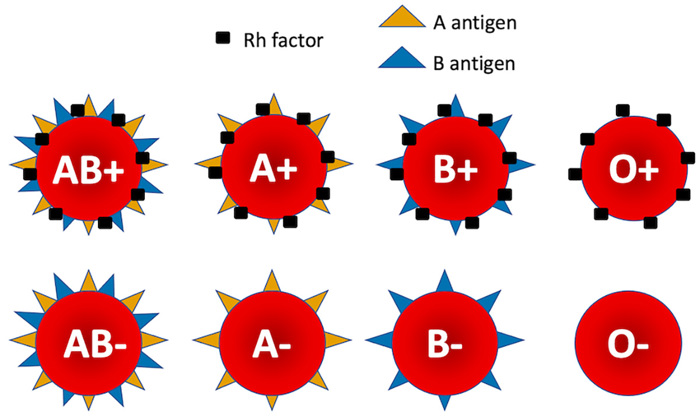Laboratory Report on Blood Types in Animal Physiology
Introduction
Until 100 years ago, it was believed that everyone had the same blood type, and therefore the tragic consequences of blood transfusion were not understood. One of the characteristics of blood groups is their hereditary nature. Blood groups are determined by the presence or absence of specific antigens on red blood cell membranes.
There are two types of blood groups:
1. ABO
2. Rh
Both types of antigens are located on the surface of red blood cells.
ABO blood group antigens still hold great importance in blood transfusion medicine. They are the most immunogenic antigens of blood groups. The most common cause of death resulting from blood transfusion is administrative error, where an incompatible blood type is injected. ABO blood group antigens also appear to have been important throughout our evolution, as the prevalence of different ABO blood groups varies among different populations, indicating a selective advantage for a particular blood group.
The ABO system genes are located on chromosome 9 and consist of 7 exons. Reactions between red blood cells and serum occur due to the presence of markers (antigens) on red blood cells and corresponding antibodies in the serum.
Landsteiner, the discoverer of the blood group system in the twentieth century, explains that agglutination occurs when RBC antigens bind to antibodies present in the serum. He named the A and B antigens and depending on which antigen is expressed by the RBCs, the blood is classified as blood group A or B. The third blood group contains red blood cells that do not show reactions as if they lack the A and B properties. This group was later named "O" after the German word "Ohne," meaning "without." The fourth blood group, AB, was added to the ABO blood group system the following year. These red blood cells express both A and B antigens.
| inheritance of blood group |
The
Rh factor is a type of protein on the surface of red blood cells. Since
proteins are inherited, this means that the Rh factor is also inherited
from parents to offspring. Its phenotype can be either positive (+) or
negative (-). Individuals who have this protein on their red blood cells
are Rh-positive (Rh+), while those who do not have it are Rh-negative
(Rh-). The majority of people (about 85%) are Rh-positive. Therefore,
each blood group can be either positive or negative.
This factor
does not cause any health problems in individuals. It only becomes
significant when blood groups are mixed, such as during pregnancy and
childbirth.
One of the most important Rh antigens includes the D, E, and C antigens. The composition of the Rh complex is still not fully understood, but it is believed to be a tetramer consisting of two glycoprotein molecules associated with RhAG and two protein molecules known as Rh proteins.
Rh can exist as RhD (carrying the D antigen) or RhCE (carrying the C and E antigens). It is unclear whether RhCE and RhD can form a single complex or not, but in individuals who are D-negative, this complex solely contains RhCE.
In conclusion, the combination of these two antigens is represented in the following image:
The ability of each blood group to donate to other blood groups is summarized in the following schematic:
Blood Type Determination Test
Materials required:
- Lancet
- Blood collection tube
- Alcohol
- Cotton
- Petri dish
- Anti-sera (A, D, B)
There are four blood types: A, B, AB, and O.
Blood Type A:
An individual with blood type A has antigen A on the surface of their red blood cells and anti-B antibodies in their blood plasma.
| A antigen and B antobody |
Blood Type B:
An individual with blood type B has antigen B on the surface of their
red blood cells and anti-A antibodies in their blood plasma.
| B antigen and A antibody |
Blood Type AB:
An individual with blood type AB has both antigen A and antigen B on the
surface of their red blood cells and does not have either anti-A or
anti-B antibodies in their blood plasma.
| A,B antigen and no antibody |
Blood Type O:
An individual with blood type O does not have antigen A or antigen B on
the surface of their red blood cells but has both anti-A and anti-B
antibodies in their blood plasma.
| No antigen and A,B antibody |
In the initial stage of the test, a cotton swab is soaked in alcohol and the fingertip of the non-specialized hand, belonging to Mohammad Sadegh Mahmoudi Lard, is disinfected with the alcohol-soaked cotton swab.
Using a lancet, a suitable puncture is made on the fingertip to create a small blood spot. On the slide, create droplets of blood as shown below. Add a drop of each anti-sera onto each blood droplet and mix them well.
[Note: It's important to handle blood and bodily fluids with caution and adhere to proper safety and hygiene protocols during the testing process.]
If after two minutes, the blood and anti-sera mixture does not form any visible precipitate, it can be determined that the corresponding antigen is not present in the person's body.
In this test (using the blood of Mohammad Sadegh Mahmoudi Lard), since there is no precipitation in any of the three blood droplets, it can be concluded that their blood type is O-. Therefore, based on the provided information, this individual has blood that lacks the ABO and Rh antigens on their red blood cells and, clinically, can donate blood to individuals of all blood types. However, they can only receive blood from individuals with the O- blood type.
| Mohammad Sadegh Mahmoudi Lord Blood Type: O- |

Comments
Post a Comment